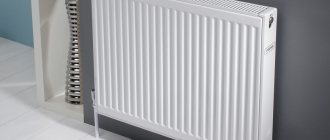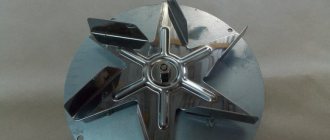Application
Everyone understands that if the heating system is of a hidden type and is located behind a layer of finishing, then in the event of a leak it is not always possible to use sealant for external use. For such cases, a sealant for internal use was invented, which must be poured into the heating pipeline system.
There are situations when a heating system leak suddenly appears, and it needs to be fixed in a short period of time, but there is no sealant with suitable characteristics at hand. In this situation, you can use automotive sealant. Or sealant for car radiators.
But in order to apply it to the surface, you need to carry out preparatory work. They include the choice of composition, and it is carried out based on the type of coolant used. If you choose the wrong composition, this can lead to clogging of pipes in some places.
Nowadays, sealants for internal use are divided into the following types according to the place of use:
- Compositions for heating systems in which the coolant is water or antifreeze.
- Mixtures for sealing joints of heating systems.
- Products for boilers that run on solid fuel or gas.
Popular among liquid sealants today are compositions from a German manufacturer. This composition provides high-quality sealing of the heating system and does not affect the heating boiler in any way.
In order to use liquid sealant for internal use, it is necessary to determine the appropriate concentration of the composition, since stopping and eliminating the leak site depends on this. If approximately 80 liters of liquid leak out of the system per day, then 1 liter of mixture is sufficient to effectively eliminate the cause.
In order to determine the total volume of coolant in the entire system, it is necessary to calculate the footage of all pipes and their diameter, but you can do it differently. Just drain the liquid into a container whose volume you know.
To use the composition in a heating pipeline, you must first bleed the air from the system. If this is not done, then under high pressure the sealant will begin to clog not only the leak site, but can also stop the circulation of the coolant in certain areas.
In order for the sealant to circulate freely throughout the system, all taps must be opened. In the first radiator, the tap must be completely unscrewed. After the process has passed, it is necessary to install the pump, warm the system to 60 degrees and pump up a pressure of 2 bar.
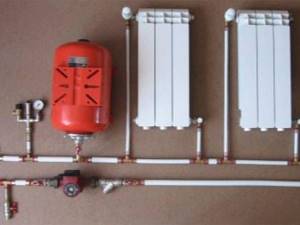
The filling of the composition itself should proceed according to the following scheme:
- We collect 1.5 buckets of heated liquid, shake the sealant composition and add it to the buckets and quickly pump it into the system.
- Next, we remove all the air from the heating system and the solution will begin to circulate through the system.
It takes approximately 3 days for all damaged areas to be sealed. After this, you need to build up pressure in the system and ensure the quality of the seal.
To learn how to fix a heating system leak using sealant, see the following video.
Steps to eliminate a leak with liquid sealant
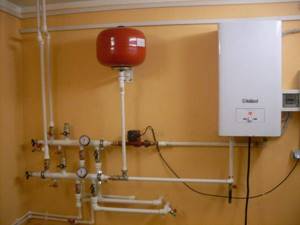
Before you start sealing possible leaks in the heating system, you need to make sure that the expansion tank is in good condition.
The procedure for using liquid sealants to repair your home heating system can seem quite complicated. In some cases, clots of sealing fluid cause partial blockage and impede the movement of the coolant. Therefore, in order not to cause damage to the heating equipment due to your inexperience, it is better to invite a specialist. In any case, you need to study the instructions for using a specific type of sealant for radiators and strictly follow them.
Having decided to use a liquid sealant to fix a problem in the heating system, you need to make sure that:
- the reason for the pressure drop is precisely the leakage of coolant, and is not related to a malfunction of the expansion tank;
- the selected type of sealant for heating systems corresponds to the type of coolant in the system;
- The sealant is suitable for this heating boiler.
German liquid sealant BCG-24 is used to eliminate leaks in heating systems
When using liquid sealant for pipes and radiators, it is important to maintain the correct concentration. On average, its values range from 1:50 to 1:100, but it is advisable to determine the concentration more accurately, since the effectiveness of eliminating leaks can be affected by factors such as:
- coolant leak rate (up to 30 liters per day or more);
- the total volume of water in a given heating system.
If the volume does not exceed 80 liters, 1 liter of sealant will be enough to pour into the heating system. But how can we more accurately calculate the volume of water in the system? You need to calculate how many meters of pipes and what diameter were laid in the house, and then enter this data into one of the online calculators. To the resulting volume of pipelines, you must also add the passport characteristics of the volumes of all radiators and the boiler.
Preparing the heating system
- Dismantle or cut off all filters with taps so that they do not become clogged with a viscous solution of sealant for heating systems;
- Unscrew the Mayevsky valve from one radiator (the first one in the direction of coolant flow) and connect a pump to it (the “Baby” type);
- Start the heating system and let it warm up for an hour to a temperature of 50–60°C at a pressure of at least 1 bar;
- Open all taps on pipelines and radiators to allow sealant to flow freely through them;
- Remove air from the entire system, including the radiators and circulation pump.
Preparing the sealant
- You can also pour liquid sealant into the heating system using a hand pump for pressure testing.
Drain about 10 liters of hot water from the system into a large bucket, use most of it to prepare a sealant solution, and leave a few liters for subsequent flushing of the pump;
- Shake the canister (bottle) with sealant for radiators and heating pipes, then pour its contents into a bucket;
- Rinse the canister thoroughly with hot water so that all remaining sediment gets into the solution being prepared.
Solutions of sealants for heating systems must be prepared immediately before use so that the liquid does not come into contact with atmospheric air for too long.
Pouring sealant
Liquid sealant for heating systems must have time to mix with the coolant before it reaches the boiler, so it is more advisable to pour it into the supply:
- Introduce liquid sealant solution into the system using a pump;
- Pump the remaining hot water through the pump so that absolutely all of the sealant sediment gets into the system;
- Bleed the air from the system again;
- Raise the pressure to 1.2–1.5 bar and maintain the system operating cycle for 7–8 hours at a temperature of 45–60°C. This period is needed for the sealant to completely dissolve in the coolant.
Use of special sealants
Unlike mechanical means, the use of sealing compounds does not provide a 100% guarantee of eliminating leaks. On the other hand, it is impossible to use clamps and tape on the flat surface of the radiator when the fistula is located directly on the front panel. There are 3 options left: try a chemical, weld the hole, or replace the battery.
Undoubtedly, sealant for pipes and radiators is the most convenient tool for the average user. Before throwing the heating device into a landfill, you can try to seal it. What sealants are usually used in such situations:
- two-component plastic composition called “cold welding”;
- liquid agents added to the coolant;
- adhesive heat-resistant plastic that hardens after ultraviolet radiation.
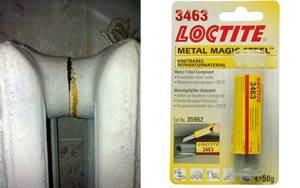
Two-component waterproof glue will definitely help if you strictly follow the technology - dry, clean and degrease the defective area before applying a patch. See the video below for cold welding tests on water pipes.
Watch this video on YouTube
Liquid sealants are offered for different coolants (water, antifreeze) and types of heating systems. After adding the product, chemical compounds fill the fistulas from the inside within 2 days. Of course, large defects and through holes cannot be repaired; you must first use a mechanical method. For example, hammer a wooden chop into the hole.
Bondic plastic gel is sold complete with an irradiator and is applied to the damage in small portions. Each subsequent drop is illuminated by ultraviolet light and instantly hardens. An indispensable condition is a dry, grease-free surface; the type of pipe material does not matter.

Plastic becomes solid after irradiation with ultraviolet light, before which the material remains liquid indefinitely.
Popular rubber sealants
It was noted above that the variety of these means is great. This opens up great opportunities for choosing the composition, taking into account the nature of the task at hand.
Construction/hardware stores stock imported and domestic sealants. It is recommended to choose a product that has passed technical control and meets current norms and standards (there should be a corresponding mark on the packaging).
To make choosing a rubber sealant as easy and quick as possible, we provide a useful overview of leading manufacturers and well-known products.
Rubber Roof Sealant Tytan
The products of this brand are well known and loved in our country, as they have proven themselves well. Tytan allows you to create a reliable waterproof connection that can withstand ambient temperatures ranging from -55 to +100 degrees Celsius.
Resistance to fungi and mold is an important feature of this composition. This allows you not to worry about the development of microorganisms in hard-to-reach places (joints between tiles, cracks between the bathtub and the wall). The sealant is indispensable when processing:
- roof ridges;
- skylights;
- sewer hatches;
- gutters;
- storm systems;
- ventilation.
For ease of use, Tytan rubber sealant is available in 310 ml tubes. It is curious that the product can withstand up to four freezing cycles, while maintaining its consumer qualities.
This sealant should be applied at positive air temperatures. The curing rate is approximately 2 mm per day.
Penosil Premium All Weather Sealant
The main advantage of this sealant is its excellent adhesion to the surface combined with a viscous consistency. The product does not flow even from vertical panels and partitions, remaining on them and hardening gradually.
Penosil sealant is indispensable when working with brick/stone masonry, monolithic concrete surfaces, glass, wood and metal. In addition, it is not so aggressive towards plastic. Complete hardening occurs 20 minutes after removal from the cartridge.
Like the previous composition, this sealant is resistant to mold. An important difference is application even at a temperature of -5 degrees Celsius, which expands the possibilities for using the product.
Body 920
Thick consistency, stability on the surface, protection against cracking - these are the main advantages of the one-component rubber sealant Body 920. It is non-aggressive to plastic, has good adhesion to metal parts and perfectly glues/seals joint seams.
Due to its availability, this composition is actively used in the treatment of air conditioning systems. It is used in the construction of small ships made of metal and wood, as well as for sealing shipping containers and processing car body elements.
Rubber sealant MasterTeks Liquid rubber
This product is good because it is suitable for work in any season and regardless of weather conditions. Made from butyl acetate and synthetic rubber, this sealant is used to restore roofing coverings and protect rafter systems from the harmful effects of moisture.
The composition has a narrower operating temperature range (from –40 to +90 degrees Celsius), but can be applied even at 10 degrees below zero. Liquid rubber is excellent for working in rooms with high humidity and is very often used for sealing building facades.
TechnoNIKOL No. 45
Another equally popular butyl rubber sealant, which has become famous due to:
- cold curing;
- low gas permeability;
- seam elasticity;
- application at a temperature of –20 degrees Celsius.
This sealant has a neutral white color and is well suited for painting. It is durable. Complete drying occurs an hour after application. For ease of use, the product is available in buckets weighing up to 16 kg.
The sealants presented have passed technical control and a number of tests, and most importantly, they have been tested in practice. These funds are available not only to professional builders, but also to ordinary consumers, which is reflected in the growth of their popularity.
Classification of high-temperature compounds
The characteristics of sealants depend on the base of the thermal insulating paste. For the treatment of fireplaces and stoves, compositions based on silicate and silicone are suitable. The first group is heat-resistant sealants that can withstand direct contact with flame, the second group is heat-resistant pastes. Their operating temperature is significantly lower than refractory compounds.
Each type of sealant has its own characteristics and priority areas of use.
Silicate – heat-resistant mixtures
Sealing paste based on sodium silicate. Externally, the material looks like a viscous black mixture. After hardening, an inelastic layer is formed on the surface.
Due to the formation of a rigid seam, it is better to use such sealants in ovens that have already had time to shrink, as well as in devices where the likelihood of vibration loads is reduced
If this requirement is neglected, there is a risk of cracking of the insulating seam.
Technical characteristics of silicate compositions:
- permissible temperature indicators: short-term – 1400-1500°C, long-term – up to 1300°C;
- hardening time – 15 minutes;
- maximum seam thickness – 15 mm;
- release form: plastic tubes;
- linear deformation without destruction of the frozen mass – 7%;
- application conditions – temperature within 1-40°C, the exact value depends on the manufacturer.
Silicate compounds have good adhesive properties. To increase the reliability of the coupling, it is advisable to pre-treat a metal, concrete or brick base with an abrasive.
Not all heat-resistant pastes are fire-resistant sealants and are able to retain their properties when exposed to flame. The packaging must bear the appropriate inscription
Heat-resistant paste is most effective when sealing joints of fixed elements with a similar expansion coefficient.
When is it advisable to use silicate sealant:
- sealing cracks in combustion chambers and other surfaces in contact with fire, as well as high-temperature gases;
- sealing cracks formed between steel and cast iron elements of stove appliances and brickwork;
- sealing of chimneys that discharge high-temperature gases, for example: solid fuel boilers and sauna stoves;
- processing of casting installation areas;
- eliminating leaks in heating boilers.
Heat-resistant pastes are used when assembling a sandwich chimney - the joining surfaces are treated with sealant.
Silicone – heat-resistant seals
Silicone-based insulating paste has a brownish-reddish color. The shade is due to the addition of iron oxide to the product. Heat-resistant silicone sealants with different operating temperatures are available for sale, the range of values being 170-300°C.
High temperature oven compounds are often confused with automotive sealants. However, they are not interchangeable. Distinctive features of pastes for heating devices: absence of a sharp acidic odor and packaging in tubes, not small tubes
Silicone sealants retain elasticity after drying - the seams are not afraid of deformation loads and shrinkage of ovens. An additional plus is excellent water resistance, which allows the composition to be used to seal cracks in areas where the roof and chimney come into contact. Silicone paste cannot be painted.
Technical characteristics of heat-resistant seals:
- operating temperature range – within +300°С;
- packaging – tubes, packed in 310 ml;
- Drying period – about 20 minutes;
- application on a cold base at above-zero air temperature, but not more than +40°C;
- resistance to UV rays;
- sealing cracks with a depth of 6 mm.
The cost of silicone thermosealant is often lower than its silicate counterpart. However, due to the insufficient temperature threshold, its use is limited to the treatment of not too hot surfaces.
Scope of use:
- sealing brick chimneys in street areas;
- sealing the joints of the exhaust duct and roofing material;
- treatment of smoke exhaust ducts made of metal, brick and sandwich panels, provided that boilers with an efficiency of over 90% are used - the temperature of the exhaust gases does not exceed +150°C;
- treatment of blind cracks on brick external surfaces of stoves and fireplaces.
The high-temperature composition is also suitable for sealing threaded connections when installing heating circuits.
Which sealant is better? Price and manufacturers
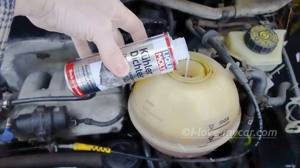
Not every sealant can be effective and safe
To decide on the choice of sealant and decide which is better, let's look at several popular examples. Not all of them work the same, they all have different prices and characteristics. Tests of radiator sealants are carried out regularly, so we provide several tables with test results, main indicators and prices.
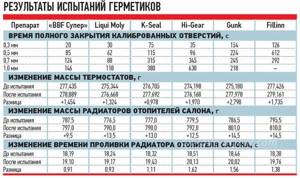
Test of sealants from the magazine Behind the wheel, as always, the results do not really coincide with real reviews

Super BBF New 325 ml
Made on a polymer base. Visually it looks like a white emulsion. Domestic manufacturer. On the market since 1996. During this time it has proven itself well. Has a fairly low price. Reviews are mostly positive. It takes 3 to 5 minutes to tighten the breakdown. Leaves minimal deposits. The manufacturer provides a guarantee of 36 hours of operation. In practice the period is much higher. Widely distributed, you can buy it at your nearest auto store. The optimal choice due to the price-quality ratio. Price: $1.3. Article: 3322.
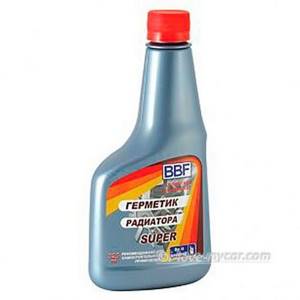
Application:
- Turn off the engine.
- Allow the engine to cool to 60 degrees.
- Shake the tube several times.
- Fill it into the radiator or expansion tank (the instructions do not specify the volume of sealant per liter of coolant).
- Start the car. Let it run for 10-15 minutes at idle speed.
Liqui Moly Kuhler Dichter 250 ml
Polymer base. Sealant from a famous German manufacturer. Suitable for eliminating microcracks and small bruises. Mostly, the manufacturer indicates that the product contains water-soluble monomer and plastic chips.
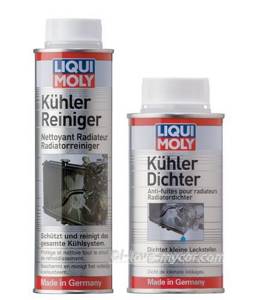
Reviews vary, from sharply negative to extremely positive. Associated with a large number of fakes. The price is about 5.2 dollars. Application:
- Shake the product.
- Start the car.
- Turn on the stove at maximum speed.
- Pour the solution in a ratio of 25 ml per 1 liter of coolant.
- Let it run for about 10 minutes
Hi-Gear Radiator Stop Leak
The American manufacturer gained its popularity thanks to high-quality decarbonization of the fuel system. Specializes in additives, additives and other auto chemicals. The sealant can eliminate fairly large damage. Reviews are mostly negative. The reasons for this are a large amount of deposits and problematic cleaning of the system.

Late activation of the product is also noted - up to half an hour. In such a situation, it is most likely that the coolant will not be preserved. The positive side is the longest service life among competitors - about 90 hours. The composition forms a durable shell and lasts for a long time.
Price: For 444ml $6.7, for 325ml they ask for 50 dollars. Article: HG9029 – 444 ml, HG9025 – 325 ml. Application:
- Turn off and let the engine cool.
- Drain 2-3 liters of coolant.
- Shake the can thoroughly.
- Pour the mixture into the radiator or into its upper pipe (15ml per 1 liter of coolant).
- Allow the engine to cool completely, then start it.
- Warm up for 5-7 minutes.
- Then turn it off again.
Wait 10-15 minutes.

Cooling system pump after treatment with Felix sealant
Types of sealants
Based on their composition, sealants are divided into three types:
- Acrylics are unstable and do not tolerate temperature changes well.
- Polyurethane - characterized by elasticity, good adhesion to metal surfaces, resistance to corrosion and high temperatures.
- Silicone is the most common type of sealant due to its versatility. Moreover, this product retains moisture resistance and elasticity in a fairly wide range of temperature conditions.
- Liquid polymer - used in heating systems specifically to eliminate leaks. They are a liquid that polymerizes upon contact with air.
Below we will take a closer look at the most common types of sealants.
Universal silicone
The most common today is a universal heat-resistant sealant, which is most often used to seal joints. This composition has all the necessary qualities.
In particular, among its properties the following points can be highlighted:
- Good strength;
- The composition is quite liquid and fluid, thanks to which it is able to penetrate even the narrowest crevices;
- Good elasticity.
It must be said that this sealant is used not only for heating systems, but is also used for other household purposes, as well as in industry.
Polyurethane
A distinctive feature of these compounds is durability and resistance to aggressive environments, as well as mechanical stress. In addition, the advantages include the cost-effectiveness of the composition.
It should be noted that polyurethane sealants come in one- and two-component types. The former take longer to harden, however, their price is lower. It must be said that despite a lot of positive qualities, polyurethane compounds are less common in everyday life than silicone ones, as they are more expensive.
Liquid polymer
All of the above compounds are intended for external application to the radiator or processing of threaded connections. But, in some cases, it is impossible to seal a leak from the outside, for example, if it is difficult to detect the damaged area. Then a polymer liquid sealant comes to the rescue.
The principle of its operation is based on the fact that it is poured into the system along with the coolant. In the area where there is a leak, the composition begins to interact with air and polymerize. Thus, clots of the composition seal the gap.
It should be noted that there are several types of liquid sealants:
- For systems operating on water.
- For systems running on antifreeze.
- For sealing metal surfaces.
- For plastic pipes.
Thus, before purchasing the composition, you should read the information contained in the instructions on the package.
Types of sealing compounds, their characteristics and methods of application
Based on the place of use, sealants for heating systems are divided into compositions:
- for external use - applied to the site of damage to the pipeline from the outside and, after curing, restores the tightness of the system;
- for internal use (liquid, volumetric action) – they are introduced into the circuit and seal damage from the inside;
- sealing - applied to gaskets and threads to improve the tightness of connections.
The choice of sealant type depends on the degree of damage and accessibility of the repair site. In addition, the choice of sealing composition determines the method of preparing the heating system for the upcoming repair.
Let's consider sealants in relation to common types of damage and connections of heating system elements.
Sealing compounds for external use
These sealants are produced as one or two component sealants.
Considering that the coolant in the pipes of the heating system is not only hot, but also under pressure, damage to the pipeline should be sealed with particular care. First of all, the sealant must be designed for operation at high temperatures, which is indicated on its packaging in the form of the “heat resistant” marking and the operating temperature range.
Important! Acrylic-based sealant (acrylic) is used only for sealing cold water pipelines. Acrylic glue is not suitable for repairing pipes of heating and hot water systems, since after curing it is not plastic and therefore collapses due to thermal deformations of the base.
Among the one-component compositions for repairing water heating systems, silicone-based sealing adhesives are common.
Heat-resistant silicone-based sealants
To restore the tightness of heating systems from the outside, the most common use of sealants based on various types of silicone, including rubber.
To repair steel pipes, it is necessary to use neutral types of silicone (a mark with this parameter is available on the packaging), because “acidic” silicone adhesives that are also produced, which form acetic acid during curing, react with the metal.
If the material meets the required temperature requirements, it is necessary to enhance the effectiveness and reliability of its application with additional means to ensure success. As a rule, the manufacturer recommends such sealants for use as a filler for cracks or holes. If the material indicates another application, but its characteristics and potential are high, the adhesive is quite suitable for use. For example, a composition recommended for sealing components on an engine can easily cope with the same task in a home heating system.

And yet, taking into account the responsibility of the application, it is necessary to apply silicone sealants to the pipes of the heating system in combination with a reinforcing mesh, for which striped fiberglass tape “serpyanka” is successfully used.
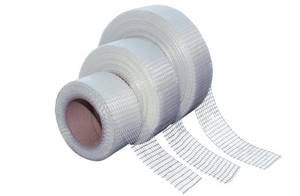
Sealing method
A layer of sealant is applied to the prepared surface of the pipe (drying, cleaning, degreasing), on top of which coils of serpyanka are laid end-to-end, then sealant again, after which the tape is wound in turns with an overlap of 1 cm. The number of layers of serpyanka with glue between them should be 4-5 , it is necessary to prevent the formation of air bubbles or loose areas between them. The last 2-3 turns of the serpyanka are made on a section of the pipe without glue and are tightly attached to it with a nylon clamp, which, after the silicone has cured, will be removed along with the excess turns of the tape. The top repair layer is made of sealant and smoothed out.
Work should be carried out at a temperature not lower than +5 °C, silicone should be at room temperature (20-25 degrees). Curing of the composition, which occurs due to contact of silicone with moisture, occurs depending on the type of silicone and amounts to several millimeters per day.
Products that have proven themselves abroad and in Russia are silicone sealants MakroFlex, Masterteks, Titan, MasterSil.

Two-component compositions for repairing heating and hot water systems are various types of adhesives based on epoxy resins and polyurethane.
These compositions are less common for pipeline repairs, since they require certain skills in maintaining proportions when preparing the mixture, have a short “survival” time of the solution after mixing the components, and have a high cost relative to other adhesives.

There are also one-component polyurethane sealants that cure upon contact with air. The quality of these mixtures is also high, curing takes a little longer than two-component compositions, and they are also much more expensive in price than silicone materials. The main disadvantage of polyurethane sealants is toxicity during work - there must be good ventilation in the room, and work must be done in protective clothing and gloves to avoid getting glue on exposed skin.
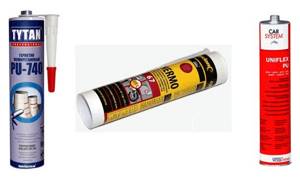
To guarantee success when using two-component compositions, it is also necessary to carefully prepare the section of pipe being repaired and use reinforcing tape – serpyanka – in combination with glue.
Primary requirements
Sealant for heating radiators can be useful not only during the installation of the latter, but also during repairs, for example, when the batteries are disassembled into sections or a leak appears in them. The use of this substance will guarantee the tightness of all joints, which will not be broken even after heating is completed.
It should be emphasized that there is currently a wide range of different types of sealants on the market, which are intended for various purposes. Needless to say, this pairing makes the choice difficult.
Based on this, in order not to make a mistake, you should first of all decide on the basic requirements that a given substance must meet.
So, taking into account the conditions under which the sealant will be used, it is possible to come to the conclusion that it must have the following qualities:
- Heat resistance;
- Resistance to deformation;
- Moisture resistance;
- Resistant to temperature changes.
Below we will consider which specific types of sealants meet these requirements.

Pros and cons of using liquid polymer materials in plumbing
Manufacturers claim that anaerobic sealants are an ideal material with no disadvantages. However, professional craftsmen were able to discover several minor disadvantages during use.
| Advantages | Flaws |
| The compound does not lose its properties at temperatures in the range of -196º, -60º to 150-300ºС. High resistance to mechanical and dynamic loads. Economical material consumption. Neutrality to aggressive environments and vibrations. After hardening, it does not dissolve in water. Possibility of reliable connection of materials of different structures. Resistance to high pressure: about 50 atmospheres and above. | Dependence on low temperatures - hardening time increases. Limited use - not recommended for sealing pipes with a diameter of M80 and above. Sensitivity to moisture - applied only to dry surfaces. They provide strong fixation and are therefore suitable only for permanent connections. |
Some installers express dissatisfaction with the high cost of products. However, the price seems quite justified, given the quality and economical consumption of the composition.
3
Types of compounds - what are the means for fixing compounds?
To be able to use the composition when installing different degrees of complexity, there are several types of sealants on the market. The main difference between them is their viscosity, fluidity and ability to penetrate into the thinnest crevices. In addition, the product can be intended not only for sealing threaded connections, but also for fixing fittings, flanges and bushings. On the container of the composition there are always tables and instructions with the help of which it will be possible to determine the suitable areas of its use.
Depending on the degree of strength, sealants are divided into three types: standard, medium and high strength compositions. Products of the first category are used to work with connections that, as a rule, are not subject to vibration. These compounds are also used in cases where pipes need to be dismantled frequently. The stall power of such devices ranges from 4–9 Nm. This allows you to remove hardened sealant without the use of special tools.
Waterproofing with anaerobic sealant
Medium strength compounds are used in service and repair work to secure connections exposed to vibration or high pressure. In such sealants, the breaking power ranges from 15 to 22 Nm. Dismantling of this type of product requires the use of tools or heating with fire. Third class sealants are used for threaded connections that are not planned to be removed in the next few years. Such products can withstand the strongest vibrations and very high pressure. To break a connection treated with such a sealant, a force of at least 55 Nm is required.
Liquid sealing compounds
In the process of repairing heating devices, compositions for external use are most often used. However, a situation may arise where these products are not suitable for repair work. For example, for hidden leaks, putty is not a solution to the problem; this also applies to hard-to-reach places between radiator sections.
Repairing damage with a liquid composition involves adding it to the coolant and then filling the system. As it circulates through heating appliances, the mixture will fill and neutralize small leaks. The sealing process proceeds as follows: the composition fills the damaged cavity with a slight protrusion outward. Here, when combined with air, the product polymerizes and hardens.
Liquid sealants are presented in several categories on the modern market; their difference lies in the possibility of use in certain conditions.
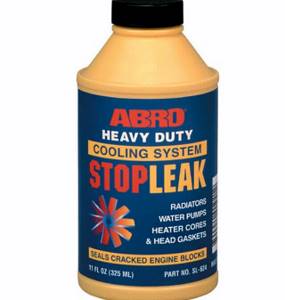
There are several categories of sealant for radiators:
- Compositions used in coolant systems can be water or antifreeze.
- Compositions that can be used in solid fuel and gas boilers.
- Compositions used for heating pipes.
Each category is used to solve a specific problem, so you should not use one of the listed compounds to fix various leaks. In this case, it is better to use a universal heating liquid sealant. However, practical application has shown that a composition of a narrow direction copes better with solving a specific problem, an analogue of a universal purpose.
How to choose?
It is important not just to choose a sealant for the radiator, but also heat-resistant options to eliminate leaks. If you notice that a joint is leaking somewhere near the batteries, you need to decide which sealant will help, and reviews can help in this matter
The choice of sealant is made based on the problems that it must solve to eliminate leaks in the heating system. If it will be used to seal the joints of the heating system, then paste-type silicone sealant is perfect for these cases.
It can be drying or non-drying version.

Differences between sealants may include the following:
- Drying compounds. After the composition applied to the surface dries, it has the ability to shrink, but this happens if the drying technology is broken. Thus, deformation of the composition may occur, cracks and drips may appear.
- Non-drying compounds. Ideal for removing small cracks and can also be used to seal heating system joints. But such compounds can be squeezed out if the pressure in the system exceeds the normal value.
Aerobic-based compounds, which are considered a type of acrylic sealants, are used in some situations to eliminate defects and leaks in heating systems. This type of sealant is able to withstand temperature changes, is resistant to mechanical stress and is resistant to alkali and acid solutions. If you apply it to the site of a defect, it quickly fills the defect and dries.
Rules for choosing a sealant
The material for creating hermetically sealed joints available on the construction market differs in consistency, degree of hydrophobicity, and resistance to strong heat. In addition, different sealants may have different service life and cost.
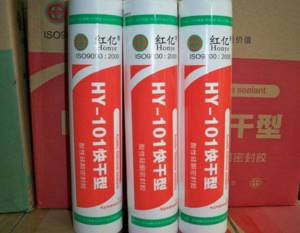
The main criterion for choosing a sealant is resistance to deformation, since constant changes in coolant temperature cause expansion and contraction of system elements. If in this case you seal the leak with a sealant that is quite brittle in its solid state, then when the surface expands, it may crack. If the leak site is treated with a more elastic material, then cracks will not appear.
Sealing of threaded connections
Liquid sealants for such purposes are made on a silicone basis. They have a good reserve of heat resistance and facilitate the installation of heating connections due to their lubricating properties. A threaded joint with such a sealant is easy to disassemble, compared to flax tow or FUM tape. Connection solutions are divided into two categories:
- Drying sealants. When the solution dries, it shrinks and there is a risk of cracks and leaks;
- Not drying out. They are well suited for eliminating leaks, making it easier to disassemble threaded connections, but under strong pressure they are squeezed out of the joints.

Anaerobic sealants
A separate group is represented by anaerobic sealant. Resistance to temperature fluctuations, mechanical stress, and good leak neutralization made it possible to use an anaerobic solution even in rocket science. In heating systems, the main advantage is the substance’s resistance to compounds containing acid and alkali. Thanks to this property, the anaerobic sealant in the system does not interfere with cleaning with chemical compounds and the use of various coolants.
In the liquid state, an anaerobic solution exists only in the presence of air. Finding itself in a closed place between the parts, it easily fills all the remaining free space and quickly hardens. The latter quality gives reliable threaded fixation and eliminates the need for great physical effort when screwing parts.
Important! The rigid adhesion created by the anaerobic solution is a serious obstacle when dismantling heating structures. Disassembling the clamps will require good warming up, as well as the use of additional tools.
Radiator sealant rating
There are no strict domestic and world standards, regulations, technical and resource tests of the properties of sealants for radiators.
To compare the performance characteristics of repair additives, a technical control section of the pipe is usually used, in which holes of different diameters from 0.2 to 1 mm are made. This section is fixed on the breadboard between the radiator and the water circuit.
After running the liquid with each of the additives, measurements are made of the rate of clogging of the defect, the mass of plaque deposits and the condition of the units after draining the antifreeze.
A comparison of the results showed:
BBF
Russian-made polymer emulsion Cost from 70 rubles. per bottle 325 ml. Traditional way of use. Fill into the radiator hole with the engine off. Then let the engine idle for 10 minutes. During the tests, the control holes were soldered according to the size gradually from 0.2 to 1 mm. As a result of the measurements, I created neat adhesions in the leakage areas.
It took 20 seconds to seal the smallest hole, and a little more than 2 minutes for the largest. Showed the smallest mass of plaque after measuring the deposits. Good performance for a small budget. High efficiency and lowest negative impact on the radiator.
Liqui Moly Kuhler Dichter
German sealant. It can be used in units with aluminum elements. Its price: from 300 rubles. per bottle 250 ml. It is poured into the expansion tank while the car engine is running. Compatible with any non-freezing compounds
The speed of adhesion on damage is proportional to the size from 32 sec. up to 2 min. When measuring deposits on the elements of the bench apparatus, it showed an average value.
The cost is fully justified by the performance properties and quality. The highest speed of formation of a sealed seam.
K-Seal
American composition, which is rarely found on sale. The radiator additive contains crushed copper in powder form. This sealant costs from 650 rubles. for 300 ml.
Relatively quickly formed a protective plug on small holes: a diameter of 0.2 mm was clogged in 35 seconds. It took more than 6 minutes for a 1 mm gap. After draining the antifreeze, the coating on the surfaces of the elements did not exceed the average value.
Unreasonably high price compared to efficiency.
Hi-Gear Radiator Stop Leak
American made radiator sealant. Not aggressive for elements made of copper, aluminum, plastic.
Its cost is from 350 rubles. Available in volumes of 325 and 440 ml.
At the same time, it created hermetic protection for all wells, regardless of size. This took a little less than 2 minutes. But the seam turned out to be unstable on larger cracks. A stable adhesion was formed only after 10 minutes. Measurement of the mass of sedimentary layers on the bench unit revealed high levels of sedimentation.
Strong but initially unstable sealing. May clog the drain neck.
Gunk Radiator Sealer Super
The gel-like polymer composition is also from an American manufacturer. Sealant for use in radiator systems made of brass, aluminum and composite materials. Used with all types of antifreeze. Added to the radiator while the car engine is running. Its price: from 400 rubles. for 440 ml.
In bench tests it demonstrated average adhesion speed on damage. For a hole with a diameter of 0.2 mm, more than 2 minutes were spent; a hole with a diameter of 1 mm was tightened in 3.5 minutes. Measurements revealed high sediment values
Should be used with caution in high mileage vehicles
Gunk radiator sealant contains components that may be harmful to health if they come into contact with mucous membranes.
Fill inn
A young brand of a domestic manufacturer. The manufacturer positions its products as specially developed for Russia and the CIS countries based on foreign components. This composition costs from 60 rubles. for 350 ml. The method of use is classic (with the engine off).
It took 10 minutes to seal the holes down to 0.8 mm. The 1 mm diameter gap still did not close after 20 minutes. Measurements revealed the greatest weight of plaque after testing.
The main advantage of this engine cooling system sealant is the cost.
After 10 hours of loading and circulation of liquids of all sealants in the bench circuit, not a single hole leaked.
Scope of application
Liquid sealant has a wide range of applications and can be used to perform various types of work.
- Fixation of various surfaces. In this case, the sealant is similar to “liquid nails”. It allows you to fasten together various materials, including materials of different textures. The resulting layer of composition is transparent, invisible, but very durable - it can withstand up to 50 kg. Suitable for joining ceramic, glass, textile, plastic and silicate surfaces.
- Plumbing work. Allows you to eliminate leaks that are invisible to the eye or located in hard-to-reach places in heating systems, gas supply, water supply, sewer pipes. It is used for sealing joints between sinks and pipes, pipes and radiator and boiler systems. Can be used both at home and in public institutions.
- Car repair. Suitable for filling gaps in various car systems, can be used when replacing gaskets in a car's cooling system.
- Sealants working on the “liquid plastic” principle. Suitable for eliminating cracks in plastic windows, as well as other PVC-based surfaces. They contain adhesive components, including PVA, due to which the solidity of the material is formed.
- Work and operation involving harsh conditions. For these purposes, polyurethane foam compositions are used, which are characterized by increased resistance to moisture, high and low temperatures, and chemical reagents. Such solutions are called “liquid rubber” because the seam formed is similar to this material.
- The scope of application of liquid sealants based on polyurethane foam is also roofing work - filling joints and cracks. In this regard, the composition is sometimes called “spray waterproofing”.
- Polyurethane foam sealing compound can eliminate a puncture in a car tire. The inner surface of the wheels of cars operated in harsh conditions can also be filled with this sealant. In this case, it plays the role of a protective layer.
How to fix a leak in a radiator with sealant?
The sealant is a special composition for sealing cracks and holes in the cooling system and in particular in the radiator.
There are several types of sealing agents:
- Powder. We fill the radiator when a coolant leak occurs. The simplest and most popular option among owners of domestically produced cars is mustard. Some car enthusiasts even use tobacco and other equally exotic substances for these purposes.
- Advantages. The advantages of dry products include low cost and the ability to eliminate small defects (up to 1 mm).
- Flaws. There is also a significant drawback, which is that not only leakage points are clogged, but also the radiator channels in the interior cooling and heating system.
- Liquid preparations. Preparations of this type are based on polymers with the addition of small metal particles. As a rule, such products are used to eliminate leaks in the engine block, but also partially in radiators. The operating principle is as follows: polymers cling to small roughnesses and sharp edges and envelop them.
- Advantages. The advantages of this option include the fact that the sealant is constantly present in the coolant and when it is replaced, it is removed from the cooling system.
- Flaw. Only small holes (no more than 1 mm) can be sealed with a polymer preparation;
- Modern polymer-type products. Products of this type contain special fibers. A striking example of such a substance is the sealant for radiators LAVR STOP LEAK. Thanks to the fibers, the adhesion of the particles of the product between themselves and the edges of cracks improves.
- Advantages. The main advantage of this option is that in a few minutes you can seal a hole up to 2 mm.
- Flaws. High price.
Sealant for car radiator - application
The main mistake of most car enthusiasts is that they do not know the main function of the seal. And it is simple - eliminating coolant leaks during temporary use. Therefore, it is recommended to use a sealant only in cases where it is not possible to eliminate the leak in stationary conditions or in the garage.
If a sealant was used to eliminate the cause of the leak, then, if possible, drain the coolant, flush the system and carry out a full repair of the radiator.
Driver actions when using sealing agents:
- A temperature sensor can indicate a leak from the radiator while driving. If the car is parked, then a puddle of coolant can tell us that it is necessary to check its level.
- If such a problem does arise, then turn off the engine, wait until the coolant cools down and proceed to inspect the damage. If the liquid still continues to flow, install a container under this place to collect it.
- Remember! Do not open the radiator cap of a car while the engine is running or hot, as this can cause serious burns.
- If you have a powder or liquid product on hand, then place it in the radiator according to the instructions.
- Next, we start the engine for a few minutes, turn it off, and after a while we check again for leaks with the unit running.
- If the leak is small and the sealant was used in accordance with its instructions, then the coolant should no longer leak.
- In cases where the defect could not be eliminated, this may indicate to us that the hole is large. In this case, soldering is no longer necessary.
How to choose the right sealant?
To make the choice easier, a summary table with two characteristics will help: the time of clogging of holes of different diameters and the level of deposits. To evaluate the last parameter, we used the mass of the thermostat before and after applying the additive. Such testing of sealants was carried out at the Department of Internal Combustion Engines of St. Petersburg Polytechnic University.
The table shows that sealants cope with microcracks successfully, even large holes are blocked within 2-10 minutes.
Applying a mask
To achieve a visible result, before applying the mask, you need to steam your facial skin well and open the pores. To do this, hold your cleansed face over a steam bath prepared with a series of steam baths for about ten minutes.
- Wipe your face dry and immediately apply the prepared black mask to it. Be careful that the mixture does not cover your eyebrows, because when it hardens, the mask will pull out the hairs along with the blackheads.
- The effective effect is about fifteen minutes, after which wet the mask a little with warm water using a spray, grab it by the lower edges and slowly pull the film up with your hands.
- Apply moisturizer to your face and avoid going outside for one hour.
The frequency of use of this black mask directly depends on the condition of your skin. If you use it for preventive purposes, once a week is enough. In the case when the facial skin is neglected and a lot of blackheads and pimples appear on it, it is recommended to make masks twice a week. The duration of treatment is from two to three months.
The availability of components and knowledge of how to make a mask for blackheads at home will help bring problematic facial skin into order. The main thing is that when purchasing ingredients at the pharmacy, be sure to check that they are all fresh, as the effectiveness of the mask depends on this. There are no contraindications identified, so feel free to start cleansing blackheads at home.
There are plenty of recipes for black masks. You can switch to a different “composition” after each course, or you can always stick to one. But dermatologists and cosmetologists recommend changing skincare products every six months, since the skin develops immunity to them and over time the effect of masks will become weaker.
How to flush a radiator from sealant
As mentioned above, the use of sealant leads to the formation of plaque in the car’s cooling system on the internal surfaces of its components, which interferes with its normal operation. The consequence of this is the need to clean the system from contaminants using special means. There are several types of them, including the so-called folk, homemade and factory-made.
Please note that proper cleaning of the cooling system will reveal damage that was sealed with sealant. Therefore, after cleaning, it will be necessary to carry out a full repair of the system by replacing damaged components or soldering them.
Thus, folk cleaning products include citric acid, acetic acid, the famous Fanta drink, lactic acid, whey, caustic soda. You can also dissolve the radiator sealant using factory-made products, which are currently abundant on the market. Some of the most popular are LAVR Radiator Flush Classic, Hi-Gear Radiator Flush, LIQUI MOLY Kuhler-Reiniger. They effectively clean the radiator and other elements of the cooling and heating system. Please read the operating instructions carefully before using them.
How to flush the engine cooling system?
List of products for cleaning the engine cooling system. What is better to rinse, and what not to clean the radiator and the entire system Read more
Conclusion
Using radiator sealant is a good temporary solution to fix an antifreeze leak, provided the damage is small. However, its constant use leads to significant clogging of not only the cooling system, but also the engine itself. On the Internet you can find many unpleasant stories about how sealants used on a regular basis literally “killed” internal combustion engines. Therefore, whenever possible, after using radiator sealant, perform appropriate diagnostics and repairs.
As for choosing a particular sealant for a radiator, it is better to use proven factory products, for example, those listed above in the rating above. It is undesirable to use folk remedies such as mustard or cigarette tobacco. This will significantly contaminate the cooling system, reducing its efficiency and shortening its service life.
Factors that cause radiator damage
In order not to have to figure out ahead of time how to properly fix a leak in a cast iron heating battery, you need to understand that structural damage is most often caused by temperature changes in the system and water hammer. Despite the fact that such radiators have increased resistance to various negative factors, they can also fail. Large changes in the temperature of water or other filled coolant negatively affect the condition of the batteries.
If liquid hotter than 100C circulates in the system, gaskets and sealants may eventually be damaged. When water boils, the pressure in the central system can rise several times. This situation does not exclude damage to entire sections. In some cases, the radiator may even burst.
When a previously working battery leaks, the main reason may be due to improper installation of the equipment. This problem can arise just 1-2 years after installation. If cast iron products were chosen to complete the system, then the risk of manufacturing defects cannot be excluded. That is why it is better not to save on heating equipment, so that in the end you do not have to overpay for unscheduled repair work.
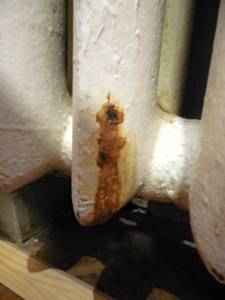
Destruction by rust
Glue or seal?
Did you catch the difference? Can you replace one with the other? Possibly in certain intended conditions. There are cases when liquid nails are used for sealing: window and door frames, plumbing, insulating seams, sealing cracks, filling cracks, and laying tiles on the sealant.
In this situation, consider the quality of performance. According to the technology, liquid nails are applied in thin strips or pointwise; irrationality will greatly affect expensive materials. When drying, the glue forms hardness and breaks down at the slightest shift. The sealant is applied with a long seam on flat surfaces, when it dries it shrinks and becomes elastic and plastic. The influencing factor on the choice of liquid nails is the adhesive strength, drying time, exact composition, and the sealant is intended for use and is gradual in nature.
Read with this
- What to do if the heating battery is leaking
- Sealing windows to protect against precipitation and noise
- How to bleed air from a heating battery: properly remove air pockets
- Air heating system: efficient heating and air conditioning
- Heating system for a private house in Leningrad and its diagram
- Do-it-yourself heat accumulator: making a heat accumulator for heating step by step
- Manifold diagram of the heating system. what is superiority?
- Radiator cap: device and possible malfunctions
- Radiator plugs: installation nuances
- Providing heat to apartment buildings: centralized heating system
Requirements for sealing materials for heating systems
The first thing you need to do if the heating system is leaking is to eliminate the leakage of the coolant, either seriously or temporarily, before making major repairs. And the main thing that needs to be ensured when installing heat supply is its reliable impermeability.
From these factors arise the requirements that apply to sealants used in the installation and repair of water-type heating systems:
- ease of use;
- thermal stability;
- high adhesion and strength;
- fairly rapid achievement of a sealing effect;
- safety of use.








